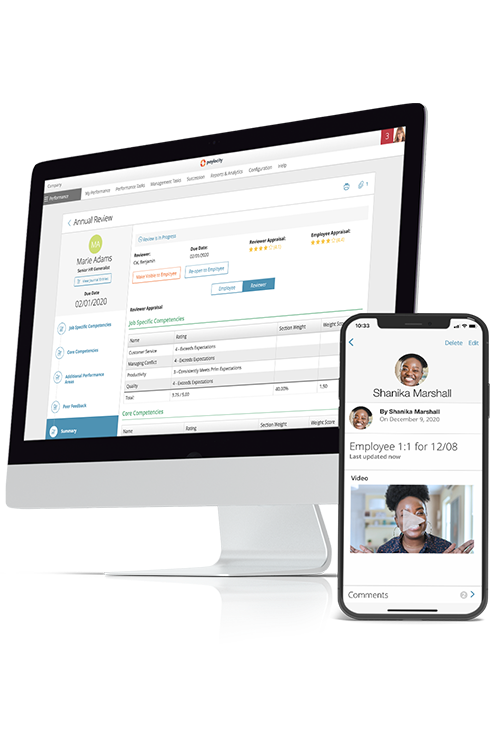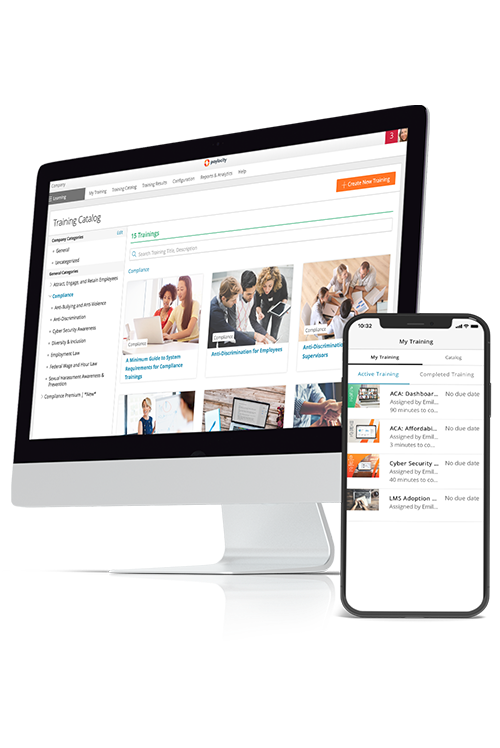resources
Using Skills Gap Analysis to Develop Your Employees
July 31, 2023
Learn how to conduct an effective skills gap analysis and ensure your organization reaps the benefits.

Whether you run a whole company or an HR department, you know your business is only as strong as its people. Each of your employees brings their own set of skills to the table. And working together, these skills produce results far greater than the sum of their parts.
However, synergistic skillsets don’t just appear out of thin air. They must be carefully sourced and curated. The nightmare for HR teams is that the target is always moving.
When was the last time you had a thorough audit of company-wide skills? Moreover, what systems do you have to conduct an effective skills gap analysis anyway?
In this article, we’ll cover the basics of performing a skills gap analysis and how you can implement one for your organization.
Key Takeaways
- A skills gap analysis identifies which skills your organization lacks for future success.
- It typically involves building a skills inventory, which is then used to determine specific areas of improvement.
- This information helps HR formulate a people strategy, improve workforce planning, and develop professional development approaches.
Understanding the Skills Gap
The skills gap is the distance between the skills your employees, teams, or organizations currently have and those required for their success.
Thanks to technology advancements like AI and data analytics, the workforce skills gap is gaining sharper claws and stronger jaws daily. Left unchecked, businesses that ignore it run the risk of being ripped to shreds.
A total of 87% of companies say they have skill gaps now or expect to over the next few years.
There’s no doubt that it’s a looming threat to businesses. So what can you do to defend against it? The best course of action is a skills gap analysis.
What is a Skills Gap Analysis?
A skills gap analysis is the workplace equivalent of going to the doctor for a check-up. It’s a set of processes that help businesses identify organizational and individual areas of weakness. Employee skill sets are assessed for competencies regarding their current job roles and future business needs.
Skills gap analysis helps shine a light on pressing issues that need to be addressed rapidly. This information helps HR formulate a people strategy, improve workforce planning, and develop professional development approaches.
A skills gap analysis can be conducted on several levels:
- Individual
- Team
- Project-based
- Department
- Entire organization
- Industry-wide
The Benefits of Performing a Skills Gap Analysis
Besides arming your organization with insightful information, a skills gap analysis provides additional benefits as well.
Paints a Vivid Picture of Your Current Team
Like the interactive exhibits at the Smithsonian, a skills gap assessment helps your HR team get a granular view and analyze the total skill assets in the company down to each individual. It streamlines the identification of your high performers and what skills bring the highest rate of return.
An effective analysis also highlights team members who aren’t pulling their weight and which competencies are severely lacking in your organization. This empowers HR to maximize skills and improve the employee experience.
Supports Learning and Development
With accurate information, you can employ better upskilling and reskilling tactics for the most desirable or useful competencies.
Depending on what skills are needed, you have a range of solutions for learning and development (L&D) strategies:
- In-house coaching or mentoring via high performers and leaders.
- Existing training resources for hard skills.
- Implementing learning and certification programs from both online and offline sources.
- Outsourcing training to a third party.
Having a current snapshot of your fulfilled and lacking skills lets you pick the most effective L&D approach.
More Efficient Talent Recruitment
Attracting and retaining star talent is difficult. You can’t afford to miss a beat and waste your efforts on a candidate with redundant skills. With skills gap analytics, your recruiters can better identify applicants that patch up the holes in your organization’s boat.
With better hiring decisions, you can expect a more productive workforce. Productive employees are also happier and, therefore, much more likely to stay with you for the long haul.
A Better Foundation for Workforce Planning
A skills gap analysis is the foundation for strategic workforce planning and human resource management. After all, HR is all about getting the right people in the right positions at the right time.
Conducting a skills gap analysis lets you know who the right people are, where they’re needed, and when (now or soon) they need to be brought on board. By addressing skills gaps, your HR team can continue to focus their efforts on other areas, such as inclusivity, diversity, and teambuilding.
How to Conduct a Successful Skills Gap Analysis
Performing a skills gap analysis isn’t exactly a brief, effortless process, regardless of how much we’d like it to be. However, you can make sure you get things right by following the necessary steps:
1. State Your Purpose
Like most analytical approaches, everything starts with a purpose or a goal. What are your business’ goals for growth in the next five years? What departments or business areas are lagging behind? What areas are excelling?
These types of questions will be your reference points before going on your skills gap journey. The purpose of the analysis is to identify what skills are required, but business or departmental goals give context as to why those skills are necessary.
2. Identify Trending Skills
Next, you need to ask questions regarding the future of the business. Looking two to five years ahead, what skills are most valuable to the business? What current and future jobs can be automated? What workloads can be severely reduced by technology?
To answer these questions, you’ll need to include current and planned technology adoptions for the company. Researching industry trends will also help guide you in prioritizing future skills. For example, AI and automation can eliminate administrative tasks, so you can place these skills at the bottom of your hierarchy.
Your skill rankings will inform the rest of your skills gap analysis.
3. Evaluate Your Team
It’s now time to get in the trenches with your people. Depending on the scope of your analysis or the size of your organization, skills evaluation can be daunting.
But, there’s an array of sources you can use to start compiling your team’s skills, such as:
- Performance reviews
- Self-evaluation surveys
- 360-degree appraisals
- Conversations with frontline managers
- Past work experience
- Employee certifications, degrees, and other qualifications.
During this process, it’s important to make sure your team is aware you’re conducting a skills analysis and not a job analysis. People need to know their jobs aren’t under threat, but that areas like training and recruitment are being optimized.
4. Compile Assessment Data
At this point, you’ll most likely have huge swaths of data. How can your HR team make sense of it all, especially if it comes from several sources? Even for small organizations, this is challenging.
The simple answer is to leverage comprehensive HR technology, like a Human Resource Information System (HRIS), to compile this data in one centralized database.
These platforms allow for robust skills tracking, which you can customize based on your organization. An HRIS can also house employee assessment data, including performance reviews and peer feedback, within each employee’s record.
After you’ve entered your evaluations and criteria into your HRIS, it becomes much easier to run reports and start generating actionable insights.
5. Deduce the Skills Gaps
Now it’s time to dive into the data.
If you used an HRIS, you should be able to run reports to gain an inventory of your workforce’s skillsets (otherwise, you may need manually review your info within a spreadsheet). Then slice this data across teams, departments, positions, locations, and other parameters to start uncovering trends and gaps.
You may find your sales team lacks customer relationship management (CRM) proficiency. Or maybe one branch of your business only has a few employees with the necessary certifications.
This step might induce a bit of anxiety, but fear not. Identifying skill gaps is the first step to success.
6. Design Interventions
After a skills gap is identified, it needs to be filled. That’s straightforward enough, right? The real question is how do you fill in the gaps?
You can leverage your existing human capital with talent development strategies. These approaches implement upskilling and reskilling initiatives. The former uses resources to grow employees in their current roles, while the latter is training them to move into new roles and departments.
Both upskilling and reskilling will help you fill skills gaps and facilitate succession planning, but the reality is you may need to look outside the organization as well to fill the identified gaps. Implement skills assessments as part of your recruitment strategy.
If spotted gaps need to be filled “yesterday,” you can always look to consultants and freelancers as short-term fixes while you upskill your team.
7. Rinse and Repeat
A skills gap analysis isn’t something you do just once. Conduct it regularly — perhaps annually or even quarterly.
As a part of your strategic workforce management efforts, keep your employee database up to date with the latest information on training, skills, and certification. This makes it much easier to conduct skills gap analyses moving forward.
Continually monitor your skills gap interventions, measure for success, and adjust accordingly.
Bridge the Skills Gap With a Learning Management System
Skill gaps are a real threat to your business — if you don’t already have them, you soon will. Rather than rest on your laurels, be proactive. A skills gap analysis will help you patch the holes and outperform your competition.
Paylocity’s all-in-one HR and Payroll software makes it easy to identify these gaps and remedy them! Our HRIS suite includes features designed to help HR pros tackle these strategic challenges:
- A single employee system of record to easily house information on skills, certification, performance, and more.
- Run robust reports to uncover actionable insights and leverage AI-powered prescriptive recommendations based on employee data and behavior.
- A learning management system (LMS) to house training and coursework for upskilling your employees.
- Automated recruiting tools to make finding, hiring, and onboarding new talent easy and painless.
Request a demo to learn more about how Paylocity can help you grow and develop your workforce.




